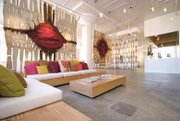Transforming the Showroom
Fashion showrooms do not need much more than a rack and the season’s “it” garment in order to conduct business.
However, a high-profile brand needs more than a showroom containing bare essentials, said Mike Gonzalez, owner of the Los Angeles–based Mike & Chris line of contemporary clothes.
Gonzalez worked with designer Drew Lage to develop a 1970s-chic department-store look for the Mike & Chris showroom inside the Cooper Design Space, located in the heart of the Los Angeles Fashion District. Gonzalez is one of a vanguard of fashion entrepreneurs who work with architects and designers to give their sales spaces some added sizzle. Gonzalez notes that buyers expect nice showrooms. “We’re in a business where everything is visual,” he observed.
Architects can transform a plain industrial showroom space into anything a designer can imagine. There’s the avant-garde–style cocoon shape covering the walls of the Ginger Showroom inside The New Mart building, also in the Los Angeles Fashion District. It was designed by architect George P. Elian. There is the warm bohemian-chic feeling of the Trina Turk showroom in the Cooper Design Space. It was designed by Los Angeles–based Barbara Bestor Architecture.
Pretty at a price
A showroom’s pretty looks do not come cheap. Entrepreneurs can spend anywhere from $100,000 to more than $400,000 to give a new look to their showrooms, according to architects. The costs include construction and materials. However, there is no direct payoff for a compelling, finished look, said Liza Stewart, owner of the Liza Stewart Showroom at the California Market Center.
But she noticed a change in buyer reaction after she designed her showroom, located on the fifth floor among other stylish showrooms that house mostly contemporary collections.
Her showroom has black walls with decorative gilded mirrors that reach from the floor toward the ceiling. After the redesign, she noticed buyers would stick around longer, and seemingly wealthier buyers and more-desirable lines seeking representation would drop by the showroom with unique looks.
The majority of showrooms today do not seek out architects and designers, relying on their own tastes to decorate, according to Ethan Eller, The New Mart’s general manager. In the late 1980s, a high percentage of New Mart tenants worked with architects and designers. But by the early 1990s, more showroom owners went solo to give their showrooms a unique look. However, working with an architect remains a popular choice for some showroom owners, Eller said.
The architects and designers must wear many hats when designing new showrooms. Probably one of the most crucial parts of the job is to find how furniture, wall coverings or even a statue can communicate the fashion statement a designer wants to make.
Cameron Smith worked as a consultant for the Twelfth Street by Cynthia Vincent showroom in the Cooper Design Space.
For Cynthia Vincent, some of the inspiration for her fashions is the aesthetic of the 1920s and 1930s. So Smith helped dress the showroom with the jazz age, art decoshy;–like silver leaf wallpaper that is now a showroom feature.
Part of what Trina Turk hoped to communicate was a California-casual lifestyle that was not the typical beach-and-nature milieu commonly associated with the Golden State.
Instead, Turk worked with Bestor to craft a bohemian look that reflected more the ambience of the Los Angeles neighborhoods of Silver Lake and Laurel Canyon than Malibu. The showroom features 9-by-10-foot macrameacute; wall hangings crafted by artist Romeo Reyna as well as throw pillows and comfortable lounge-style seating.
It also is intended to be a work space. The area where salespeople make deals over the phone is separated from the showroom’s main area by a full-height screen printed with a Trina Turk pattern, said Cathy Johnson, the project designer for the space.
Designers must make a compelling visual space, yet also ensure that the fashions will be the most eye-catching items in the showroom.
Mike & Chris showroom designer Drew Lage was charged with building a showroom that was inspired by the art deco Bullocks Wilshire department store, which was built in 1929.
For a Bullocks Wilshire ambience, Lage and Gonzalez outfitted the room with brass fixtures, some smoky bronze mirrors and sheer curtains. Yet to keep people’s minds on fashion, the furniture was kept to a stark, minimal look. “[The showroom] is its own thing,” Gonzalez said. “We just wanted an undertone of Bullocks Wilshire.”






















